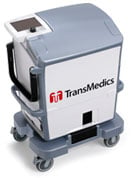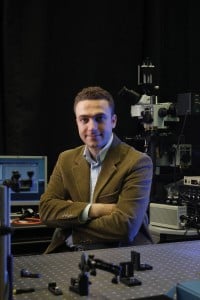"Marketing" is probably not a word that's used much in university chemistry labs; likewise, lab reagent and equipment suppliers may not consider it a key part of their job to actively promote lab safety practices. But what if marketing lab equipment safety, with all of the flash and attention-holding gimmicks in the sales and advertising arsenal is exactly what is needed to keep (often young) lab workers safe? And who knows more about marketing: business or academia?
Tags: University of California Los Angeles, California, Laboratory Equipment Supplier, marketing
 No more coolers for hearts on their way from donor to recipient. UCLA Medical has recently successfully transplanted a warm, beating heart into 61-year-old man with cardiomyopathy. The surgery was part of a clinical trial program that UCLA and other research hospitals in the United States are enrolled in to study the benefits of a new transport system for warm organs from Massachusetts company TransMedics. The warm box technology is known as their Organ Care System (OCS), and it keeps the heart beating and operational throughout transport, rather than freezing it. Specifically, the TransMedics system has these key functions, according to company specs:
No more coolers for hearts on their way from donor to recipient. UCLA Medical has recently successfully transplanted a warm, beating heart into 61-year-old man with cardiomyopathy. The surgery was part of a clinical trial program that UCLA and other research hospitals in the United States are enrolled in to study the benefits of a new transport system for warm organs from Massachusetts company TransMedics. The warm box technology is known as their Organ Care System (OCS), and it keeps the heart beating and operational throughout transport, rather than freezing it. Specifically, the TransMedics system has these key functions, according to company specs:
Tags: University of California Los Angeles, Medical Device Technology, Biomedical Equipment, California, transplant success story
 The ubiquity of cell phone technology in today's world, even in developing nations, has opened a door for biomedical researchers to invent diagnostic devices that utilize the cell phone platform to perform analyses that otherwise would require prohibitively expensive equipment. And that is just what the 32-year-old bioengineering prodigy Aydogan Ozcan is doing at UCLA's Biophotonics Lab (also known as the Ozcan Research Group Nano / Bio Photonics Lab, and contributor of the photo at right) in the Samueli School of Engineering and Applied Sciences.
The ubiquity of cell phone technology in today's world, even in developing nations, has opened a door for biomedical researchers to invent diagnostic devices that utilize the cell phone platform to perform analyses that otherwise would require prohibitively expensive equipment. And that is just what the 32-year-old bioengineering prodigy Aydogan Ozcan is doing at UCLA's Biophotonics Lab (also known as the Ozcan Research Group Nano / Bio Photonics Lab, and contributor of the photo at right) in the Samueli School of Engineering and Applied Sciences.
Tags: University of California Los Angeles, Photonics, Ozcan Nano/Bio Photonics Lab, Lab-on-a-chip Technology, flow cytometry, California, Southwest Region
For over 70 years, the Harbor-UCLA Medical Center has been home to one of the most distinguished hospitals and medical research centers in the country.
Tags: University of California Los Angeles, California, UCLA, new construction, Southwest Region
Five years ago the federal government decided that private biomedical research companies were not bringing enough new technology to patients in need, and that it would step up that process by having the NIH fund research at academic medical institutions to bridge the gap between basic science and practical treatment. Thus the CTSA was born: the Clinical & Translational Science Awards program, a research consortium supporting the translation of science into medicine by accelerating laboratory discoveries.
Tags: University of California Los Angeles, University of Minnesota, Translational Research, Minnesota, California, Southwest Region
 Now, rather sooner than one might have wished, that vision of a less-car-dependent populace is being put to the test. It's being called Carmageddon, the closure of the 405 Fwy through the heart of LA for an entire weekend this July 15th (at midnight) through the 17th. What will this human science experiment in the living laboratory tell us about Angelenos' prognosis for survival in a more sustainable world?
Now, rather sooner than one might have wished, that vision of a less-car-dependent populace is being put to the test. It's being called Carmageddon, the closure of the 405 Fwy through the heart of LA for an entire weekend this July 15th (at midnight) through the 17th. What will this human science experiment in the living laboratory tell us about Angelenos' prognosis for survival in a more sustainable world?According to a UCLA Newsroom report entitled "The Day the 405 Stood Still":
 At UCLA, shutting down is not an option: With a major hospital to run, summer camps to attend and petri-dish experiments to keep alive, university officials expect 8,000 to 10,000 people on campus.
At UCLA, shutting down is not an option: With a major hospital to run, summer camps to attend and petri-dish experiments to keep alive, university officials expect 8,000 to 10,000 people on campus.UCLA Today in its "UCLA braces for Carmageddon" piece adds:
More than 1,900 hospital employees will keep UCLA’s two hospitals purring, with several hundred doctors, nurses and other staff bunking in campus residence halls in case of an emergency. Roughly 200 children will attend long-ago promised sports camps, about 200 MBA students start classes, and 150 teachers from China will arrive at LAX to begin teacher-training on campus.
UCLA Medical Center's response to the potential nightmare is to put itself on high alert, take measures to see that it continues to function normally, and make on-campus housing available for commuting staff "in case of an emergency." Presumably that emergency would be impassable roads. They don't seem to anticipate an influx of patients as a result of the freeway closure, though the way the event is being imagined in science fiction terms makes it sound like casualties are inevitable. Will road rage turn into rioting and looting? Will there be a mass psychiatric meltdown? Will people trip on the unfamiliar laces of their walking shoes? Rest assured, more police will be out (on bicycles?), according to UCLA Today's article:
The UCPD and UCLA Transportation are among the departments scheduling extra staff to make sure everything runs smoothly, and both UCPD and the LAPD are considering overnighting in UCLA dorms.
Tags: University of California Los Angeles, Southwest, California, Los Angeles, Sustainable Architecture, UCLA, Event, laboratory
We’ve blogged about the relationship between university research campuses and the communities in which they’re situated on many occasions, usually to talk about research technologies being commercialized in the form of start-ups, sometimes in university-sponsored business parks. These new business ventures mean science talent stays local and new employment opportunities are created for locals and graduates as well. In a town or small city the university may be the biggest (if not the only) game in town economically and culturally, even geographically if it sits on enough real estate. But what is the role of the university --particularly a public university-- in a very large city with its own complex urban issues? A city like, say, Los Angeles, California?
Tags: University of California Los Angeles, California, Research Funding, Southwest Region
If your territory includes the Greater Los Angeles Area and you have products or services of interest to the life science research market, you can reach over 700 of the top thought leaders in academic science research at this week's upcoming vendor fair. Researchers actively seeking solutions to their research challenges will be attending this event.
Tags: University of California Los Angeles, California, Los Angeles, Southwest Region, marketing
The California Institute for Regenerative Medicine (CIRM) was established in 2004 when Californians passed Prop 71, a statewide ballot measure allocating $3Billion to advance and support stem cell research at California universities and research institutions.
Tags: University of California Los Angeles, Stem cell research, California, Los Angeles, Southwest Region
UCLA Biomedical Research Funding: news update
Tags: University of California Los Angeles, California, Los Angeles, Research Funding, Southwest Region

